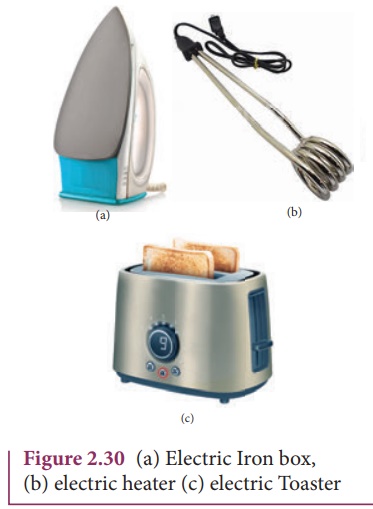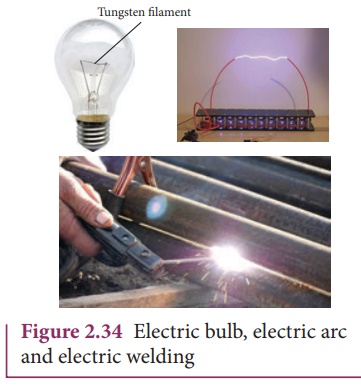Chapter: 12th Physics : Current Electricity
Application of JouleŌĆÖs heating effect
Application of JouleŌĆÖs heating effect
1. Electric heaters
Electric iron, electric heater, electric toaster shown in Figure 2.30 are some of the home appliances that utilize the heating effect of current. In these appliances, the heating elements are made of nichrome, an alloy of nickel and chromium. Nichrome has a high specific resistance and can be heated to very high temperatures without oxidation.

EXAMPLE 2.28
An electric heater of resistance 10 ╬® connected to 220 V power supply is immersed in the water of 1 kg. How long the electrical heater has to be switched on to increase its temperature from 30┬░C to 60┬░C. (The specific heat of water is s = 4200 J kg-1)
Solution
According to JouleŌĆÖs heating law H = I2 Rt
The current passed through the electrical heater = 220V/10╬® = 22 A
The heat produced in one second by the electrical heater H = I2 R
The heat produced in one second H = (22)2 x 10 = 4840 J = 4.84 k J. In fact the power rating of this electrical heater is 4.84 k W.
The amount of energy to increase the temperature of 1kg water from 30┬░C to 60┬░C is
Q = ms ŌłåT (Refer XI physics vol 2, unit 8)
Here m = 1 kg,
s = 4200 J kg-1,
ŌłåT = 30,
so Q = 1 ├Ś 4200 x 30 = 126 kJ
The time required to produce this heat energy t = Q/ I2R = 126 ├Ś103 / 4840 Ōēł 26 .03 s
2. Electric fuses
Fuses as shown in Figure 2.31, are connected in series in a circuit to protect the electric devices from the heat developed by the passage of excessive current. It is a short length of a wire made of a low melting point material. It melts and breaks the circuit if current exceeds a certain value. Lead and copper wire melts and burns out when the current increases above 5 A and 35 A respectively.
The only disadvantage with the above fuses is that once fuse wire is burnt due to excessive current, they need to be replaced. Nowadays in houses, circuit breakers (trippers) are also used instead of fuses.

Whenever there is an excessive current produced due to faulty wire connection, the circuit breaker switch opens. After repairing the faulty connection, we can close the circuit breaker switch. It is shown in the Figure 2.32.

3. Electric furnace
Furnaces as shown in Figure 2.33 are used to manufacture a large number of technologically important materials such as steel, silicon carbide, quartz, gallium arsenide, etc). To produce temperatures up to 1500┬░C, molybdenum-nichrome wire wound on a silica tube is used. Carbon arc furnaces produce temperatures up to 3000 ┬░C.

4. Electrical lamp
It consists of a tungsten filament (melting point 3380 ┬║C) kept inside a glass bulb and heated to incandescence by current. In incandescent electric lamps only about 5% of electrical energy is converted into light and the rest is wasted as heat. Electric discharge lamps, electric welding and electric arc also utilize the heating effect of current as shown in Figure 2.34.

Related Topics